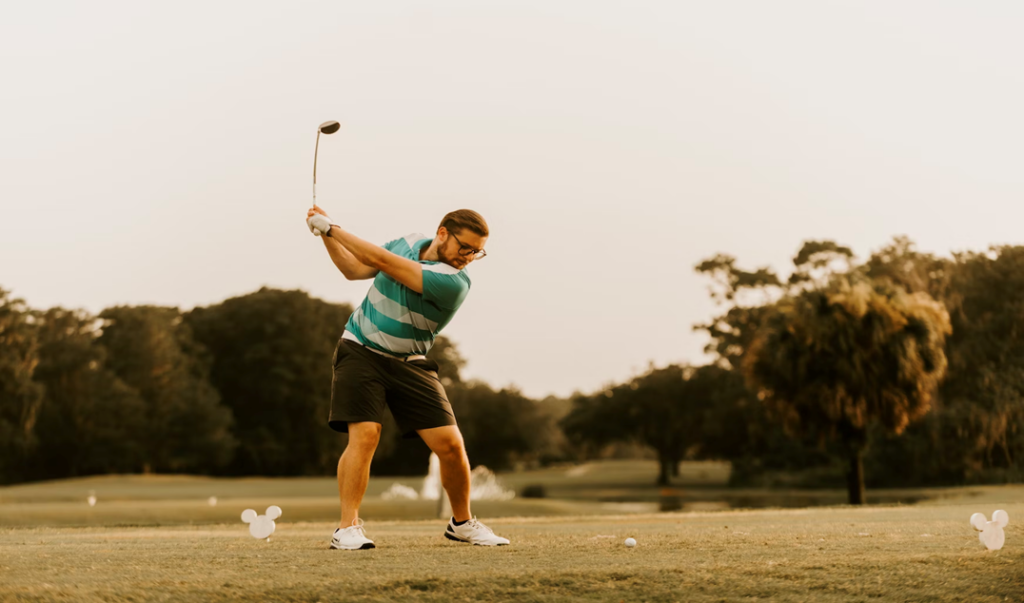There’s an erroneous myth that physical fitness and golf don’t share a significant relationship. After all, it’s a non-contact sport that requires more precision and mental toughness than sheer brute strength, right?
Well, think again.
More and more players are finding their swings improved, their drives longer, and their scores lower after integrating fitness into their training regimen.
The world’s best golf schools even go as far as incorporating fitness modules into their training programs, reflecting the increasing recognition of the important role fitness plays in golf.
Have you ever ended a round of golf feeling worn out and wondering why? After all, it’s just swinging a club and walking, right? Many golfers are discovering that their lack of endurance, flexibility, and strength may be inhibiting their performance on the course.
Even worse, these deficiencies could be setting them up for potential injuries that could keep them away from the greens for months.
Whether you’re a seasoned golfer looking to lower your handicap or a beginner aiming to master the basics, embracing a golf-focused fitness regime can revolutionize your game.
The Role of Fitness in Golf
Increased Strength: Powering Your Shots
Golf might not be as physically demanding as football or basketball, but it does require significant strength. This requirement is particularly notable in your core and forearms, muscles heavily involved in delivering a successful swing.
Core Strength
A strong core is the foundation of a powerful golf swing. When you twist your torso in a swing, it’s your core muscles that are doing most of the work. They help to maintain your balance and allow for a smooth transfer of power from your body to the club, and finally, to the ball.
Engaging in core-strengthening exercises such as planks, Russian twists, and crunches can enhance this power transfer, leading to longer drives and more precise shots.
Forearm Strength
The strength of your forearms plays a crucial role in controlling the golf club. The last point of contact between the player and the club, your grip, largely determines the direction and speed of your swing. Wrist curls, reverse curls, and grip-strengthening exercises can help increase forearm strength, thus offering better club control and more powerful shots.
Improved Flexibility: Perfecting Your Swing
Flexibility and mobility are critical components of a successful golf swing. The rotational nature of the swing requires a good range of motion in your torso, hips, and shoulders. With this, your swing could be improved, potentially leading to more accurate shots and even injuries.
Torso Flexibility
A flexible torso allows for a greater range of motion during your golf swing. This helps in creating a larger arc for your club to travel, resulting in more powerful and precise shots. Incorporating stretching exercises and movements like trunk rotations into your fitness regimen can enhance your torso flexibility.
Hip and Shoulder Mobility
Your hips and shoulders play a crucial role in creating an effective, fluid swing. A good range of motion in these areas contributes to the overall smoothness and control of your swing. Regular exercises such as hip circles, lunges, shoulder rolls, and rotator cuff stretches can significantly improve mobility in these areas, further enhancing your swing.
Enhanced Stamina: Consistency Round 犀利士
After Round
Even though golf is not typically seen as an endurance sport, a certain level of stamina is needed to maintain your performance throughout the round. This becomes even more vital during tournaments where multiple rounds are played over consecutive days.
Cardiovascular Fitness
Regular cardiovascular exercises such as running, cycling, or swimming can help boost your stamina, ensuring you still have energy during the final holes. This is vital, as fatigue can lead to a drop in performance, with swings becoming less precise and powerful.
Muscular Endurance
In addition to cardiovascular fitness, muscular endurance is essential for golfers. This refers to your muscles’ ability to perform repetitive movements without fatigue. Incorporating strength training exercises with lighter weights but higher repetitions can help build this type of endurance.
Incorporating Fitness into Your Golf Training
Developing a Golf-Specific Workout
A golf-specific workout focuses on the muscles and movements essential in golf. It often includes a mix of strength training, flexibility exercises, and cardiovascular activities.
A personal trainer or golf coach can help create a program tailored to your needs and goals. John Hughes Golf, recognized as one of the best golf schools in Orlando, offers customized coaching programs that can incorporate fitness elements.
Practice, Practice, Practice
Even the best workout plan will not replace time spent on the course or driving range. Physical fitness can improve your potential, but honing technique through practice is still key. Regular practice allows you to apply the added strength and flexibility to your swing, translating into better golf performance.
Recovery and Rest
Like any sport, adequate rest and recovery are essential in golf training. Ensure to schedule rest days in your fitness regime to avoid overexertion and potential injury. Additionally, consider adding activities like yoga or meditation to your routine, promoting both physical recovery and mental relaxation.
Conclusion
It’s time to let go of the myth that golfers don’t need to be physically fit. The evidence is overwhelming that fitness plays a crucial role in golf performance, impacting everything from the power of your swing to the endurance needed for a full round.
The best golf schools are integrating fitness into their training programs, understanding the advantage it provides their students.
If you’re serious about improving your game and ready to embrace the transformative power of fitness in golf, look no further. At John Hughes Golf, we’re prepared to guide you on this exciting journey toward becoming a fitter, stronger, and better golfer.
Contact us today and find out how our customized coaching programs can help you achieve your golfing goals.





